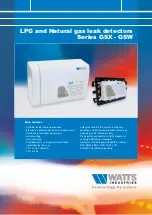
29
95-8714
6.3
CALIBRATION
CALIBRATION OVERVIEW
Span calibration is not required. The LS2000
supports non-intrusive field zero calibration,
although routine calibration is normally not
required. See Table 1 for factory span calibration
concentrations based upon variant type.
ZERO CALIBRATION
Zero Calibration is a one-step process consisting
of clean air (zero) condition adjustment only, which
is performed automatically by the device. This
procedure adjusts the “clean air” signal output only,
and is normally used if the gas output signal level
has drifted. The cause of drift is typically due to the
presence of background gas during calibration.
Additionally, the zero calibration procedure will
optimize the transmitter lamp output intensity if the
optional communication link is installed. This is
useful for situations where the signal strength at the
receiver is too large (saturation) or too small. Ensure
that the optical path is clear of hydrocarbons prior
to calibration initiation to ensure an accurate zero
(clean air) condition.
IMPORTANT CALIBRATION NOTES
NOTE
Ensure that the detector has been operating
for at least two hours before calibrating.
NOTE
Always ensure that the LS2000 optics
are totally free of all hydrocarbons before
initiating calibration.
NOTE
Zero calibration cannot be performed if
the detector is improperly aligned. When
correct alignment is achieved, the sensor
ratio (active vs. reference signals) should
be between 0.8 and 1.3. To check the ratio,
connect a HART handheld and navigate to:
Main > Detector Status > Sensor Info > Ratio
An out-of-tolerance ratio value typically
indicates incorrect alignment or presence
of background gas.
CALIBRATION INITIATION
Calibration may be initiated by any of the
following means:
• The onboard magnetic calibration switch
• Digital communication via HART (see HART
appendix), Modbus RTU, or LON communication
• Remote calibration line
Upon initiation, the LS2000 automatically performs
the zero calibration adjustment, and then signals
with a green LED when this operation is complete.
Calibration Using Magnetic Switch
The LS2000 receiver provides an onboard
magnetic calibration/reset switch for non-intrusive
calibration capability. The magnetic switch is
actuated by holding a calibration magnet at the
specified location on the device bulkhead. See
Figure 2 for switch location. An onboard multi-color
LED provides status indication during calibration.
To initiate calibration, hold the calibration magnet
against the side of the receiver at the location
shown in Figure 2. Apply the magnet for 3 to 30
seconds and release while the LEDs are flashing
yellow at 5 Hz.
Calibration Using Calibration Line Terminal
The calibration / reset function can be
accomplished remotely by installing a switch
between the CAL and 0V COM terminals of the
LS2000 receiver.
To initiate calibration, short the CAL and OV
COM terminals for 3 to 30 seconds and release
while LEDs are flashing yellow at 5 Hz.
CALIBRATION SEQUENCE
1. Initiate calibration using one of the methods
listed above:
A. The LEDs continue to flash yellow at 5 Hz.
B. The current output decreases to 1 mA,
2.2 mA, or as configured by the user.
2. When zero calibration is complete:
A. The onboard LEDs change from flashing
yellow to steady green.
B. Calibration is complete and the current
output returns to 4 mA.
NOTE
Calibration will time out if unsuccessful
after 10 minutes.
NOTE
To abort an in-process calibration, repeat
the calibration initiation sequence (e.g.,
hold the magnet for three seconds or
more and release). The device will revert
to its previous calibration setting.















































